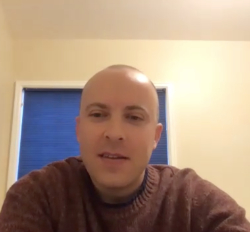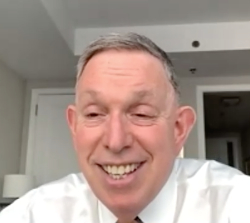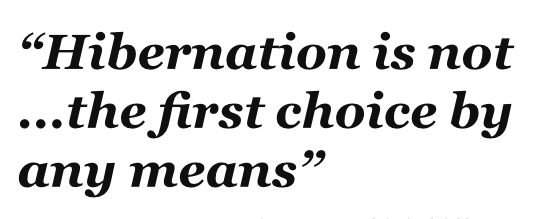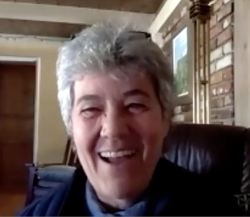ICSOM invited Michael Kaiser to speak with Member At Large Keith Carrick and Chair Meredith Snow on the current state of the arts as we progress through this pandemic. Currently Chairman of the DeVos Institute of Arts Management, Kaiser served as president of the John F. Kennedy Center for the Performing Arts from 2001 to 2014. His work leading other arts organizations, such as the Kansas City Ballet, Alvin Ailey American Dance Theater, American Ballet Theatre, and the Royal Opera House—in many cases leading them out of financial peril—has made him a much sought-after arts management consultant. He is also the author of several books about arts management (Note: see a review in the October 2013 issue). Here are some highlights; the complete interview can be found here.
Keith Carrick: Why don’t we talk about those phases that you have outlined previously:
Phase I: the sudden stop at the beginning, the lockdowns
Phase II: where we are waiting to get back into our theaters and trying to stay relevant—
 Michael Kaiser: —that’s where we are right now—Some of us can do some performance with socially distanced audience and a tiny orchestra—it’s good work to be done, but it’s not full orchestras playing for a full audience and this is the hard period because we’ve run out of our [Paycheck Protection Program] money. A lot of our funders are still being generous but not a lot of them are making these extra grants anymore, so that money’s gone and we don’t know when this ends. It’s a very uncomfortable period—wanting to be of service, wanting to keep in touch, needing to stay solvent, still having very little earned income and who knows when we can go back. And then having major contractual issues with orchestra members and other union artists. What makes sense to have as a contract right now? It’s a very hard time.
Michael Kaiser: —that’s where we are right now—Some of us can do some performance with socially distanced audience and a tiny orchestra—it’s good work to be done, but it’s not full orchestras playing for a full audience and this is the hard period because we’ve run out of our [Paycheck Protection Program] money. A lot of our funders are still being generous but not a lot of them are making these extra grants anymore, so that money’s gone and we don’t know when this ends. It’s a very uncomfortable period—wanting to be of service, wanting to keep in touch, needing to stay solvent, still having very little earned income and who knows when we can go back. And then having major contractual issues with orchestra members and other union artists. What makes sense to have as a contract right now? It’s a very hard time.
KC: Yes, of course—I think we share your opinion that this is the hardest phase for all of us. We don’t know how long it’s going to last and it’s probably the longest phase, honestly.
MK: —yes, except for Phase IV which goes on forever. But Phase III, which is the recovery phase, is an interesting time to think about. Obviously when we have a vaccine, when it’s widely available, and when it’s trusted—which are all separate things—and when we can go back into the theater and the audience is comfortable, the challenge that I’m seeing at that phase is everyone is going to be starting up at the same time. And by everyone, I’m not just talking about our cultural institutions but I’m also talking about sports, hotels, cruise lines, you name it—anyone with something that’s entertainment related. They will all at once be there—trying to recoup, trying to build back, trying to regain their audience, and it’s going to be highly competitive.
 It’s going to be a very exciting time—everyone’s going to be so happy, I know I will be when I can go back and see performances again. But it’s also going to be a competitive time with an awful lot of activity happening to compete for people’s time and attention and money.
It’s going to be a very exciting time—everyone’s going to be so happy, I know I will be when I can go back and see performances again. But it’s also going to be a competitive time with an awful lot of activity happening to compete for people’s time and attention and money.
Why I think this is critical, is not that I’m pessimistic, but that arts organizations will need to be ready to come back with real excitement and vigor. And that puts pressure on us now in Phase II. Phase II is not just about surviving, pivoting to what we can do online, and doing all the good stuff we’re trying to do now. For me, Phase II, maybe as importantly, is planning what we’re going to do in Phase III. So that when we come back, it’s really great. Because if it’s not really great, we’re not going to have the audience we need. Right now, we’re training our audiences to get the arts online for free wherever and whenever they want—maybe to enjoy a performance by a symphony in Sweden—because it’s available online now. So we have to woo our audience back and the way I think we’re going to do that is with great exciting work. I think that’s the real challenge of Phase III.
KC: Right, the planning that needs to happen. Let’s talk about Phase II since this is the part that’s the most painful for the musicians of ICSOM. I know you’ve floated this idea of an orchestra hibernating and conserving its resources during this time.
MK: That was not a prescription, you understand.
KC: Yes, I think I’m asking about what this might look like in practice for an orchestra that ends up in this place.
MK: It’s ugly. Hibernation is not a fun thing—I suggested that it is an option. It is not the first choice by any means. Hibernation basically says, “we cannot afford to live through this as a functioning institution and the only thing we can do is essentially go to sleep until there is earned revenue again.” There are some organizations for whom that is true. If they try to keep paying people and doing work right now, they would end up closed before the end of the pandemic which is no one’s first choice. The idea of hibernation was for those organizations that are simply too weak to last. The board keeps meeting to keep the legal entity alive. That’s what hibernation means—it’s not a great option.
KC: No, I would think this should be the last option.
MK: I agree. We want all furloughs to be as short as possible. We don’t want to see people losing their livelihoods. That’s no one’s choice, first or second or third. It’s the last choice. But I think what is more important, from my perspective and I would hope from the union musicians’ perspective, is that the long-term future of your institution is secure rather than that you have this burst of glory until January 2021 and then you shut your doors forever. That’s what I would like to avoid.
KC: Of course! It’s never the union’s position that we should drain the institution of all its resources.
MK: No, I know that. I’m not accusing anybody of that, I’m just saying that’s where hibernation really comes into play. To be honest, most even mid-sized American orchestras don’t have to look at hibernation because they have other resources upon which to draw. It’s really some other kinds of smaller organizations with no reserves whatsoever, who simply can’t survive any other way.
KC: One thing we’re worried about is—I’ve titled it “creative drain”—where the pandemic will affect students and even our seasoned artists in orchestras, who might choose to leave the field. I wonder if you have any ideas on how we might prevent this drain on the creative side of our profession?
MK: I hope this won’t go long enough that that will really have a major impact. Not that there will be no one who would ever decide to leave, but people may decide that anyway. For me, the thing that I believe keeps people excited and engaged, whether it’s a musician who’s thinking about their career or a donor who’s thinking about giving, is talking about the exciting work you can do when you come back. I think when the discussion is only about the here and now and the loss, that’s when we lose people—all kinds of people—musicians, donors, board members, administrators, whatever. If the conversation is more about what’s awaiting us—in six months or eight months, not so far away to be honest—that to me is the compelling message.
I find that we sometimes extrapolate from one data point in this country—things are bad, so things are always going to be bad. Where I think that is really a problem is when we forget to inspire people. We have to inspire people all the time. I frankly would rather see orchestras do one less virtual performance and one more virtual Town Hall meeting where the leadership talks to the donor base about “Here’s where we’re going. Here’s what’s going on right now, but just stick with us because this is the great stuff about to happen and you don’t want to miss it!” That’s the message that I always want to have—in a recession, in a pandemic, not that I’ve faced one before—this message of the exciting things to come. If we focus on the negative, then that becomes a self-fulfilling prophecy. You lose musicians and donors and audience and everybody.
But the end isn’t that far away. Let’s hope we’re back in September of 2021, that’s not so far from now.
KC: This reminds me of the advice I’ve read in your books about long-term planning. It seems like you are advocating “stay the course.”
MK: Yes, but I don’t want to use the phrase “stay the course.” It’s the same advice, but it’s “what’s the most exciting thing that’s going to happen.” That’s what inspires people. I think the work we did with the Baltimore Symphony last December—when they were not in good shape—we created a plan that was talking about what they wanted to do going forward. It’s exciting stuff and we raised $9 million in six weeks. And they are lasting through this pandemic in better shape than a lot of orchestras, having been, just a year ago, in dire straits.
People get inspired by the work we do. That’s why they keep giving us money. People love the art you make—so let’s focus on that. Let’s not focus on the short-term challenge. We whine too much in the arts. We complain, we share the pain too much. It’s a bad habit. That’s not why people support us—no one gives us money because we’re in pain or we’re suffering, people give us money because they’re inspired by us. We’ve got to be more disciplined about the way we talk about our challenges.
I’ll say this: I think arts organizations did much better now, in this pandemic, than they did in the recession of 2008–09. Much better. But we still have a ways to go.
KC: I’m not an arts manager, but I’d like to know how we can better prepare our managers, and future managers, for crisis planning? We’ve dealt with recessions, we all expect them. How do we prepare for what we don’t know is coming? Do we do enough crisis planning? Could we do it better?
MK: I think we could do planning better. None of us know what the next crisis will be. I spent this morning teaching a cohort of organizations in Puerto Rico. For them, the crisis was a hurricane—they didn’t predict the hurricane, no one could predict a hurricane. How do you take an exogenous shock and then deal with it? How does that flow through your logic? What logic path do you have handy so you can say “I’m going to pivot this way” because of whatever is happening in the world. It can be something huge, like a big hurricane or coronavirus, or it can be something more modest, like, all of a sudden “Hamilton is coming to our city!….uh-oh.”
I think arts organizations don’t plan well enough. They plan in a very cursory way, I find. What I do for most organizations is write a plan—so I see a lot of plans. They are way too abstract. They read like a series of wishes. “We will increase individual fundraising. We will strengthen our board. We will build our audience. We will engage our community.” That’s not a plan, that’s a wish. How are you going to do that specifically? What are you going to do to accomplish those things? Most organizations don’t plan in that depth. When something happens, they don’t have a framework to say “OK, that happened and now we have to think through how we’re going to accommodate this new reality.” I think that’s something that arts organizations, by and large, don’t do well enough.
Meredith Snow: In light of the pandemic there has been worldwide recognition of the systemic racism that exists in our country. Is there a way for us to better position ourselves now, during the shutdown, to address this issue within our orchestras?
MK: First of all, inclusivity and equity are long-term issues that have to be addressed in the long-term. By which I’m not saying, “don’t make progress now.” What I mean is that you can’t do something today and it’s fixed. For me it’s about a sustained and consistent decision to embrace diverse people in every way. Not just through your outreach activities but through the repertoire you program, the people you put in your orchestra, on your board, and in your staff, and the marketing tools you use.
It’s about changing the whole quilt of work we do. This is a field that I spend a lot of time in and I care deeply about. I see too many organizations who think they can do one work by a Black composer and now “we have done it.” That’s not how it works. It’s about consistently working to build a family of people who care about you.
And to build this family into a diverse family. What brings people to you is the work you do, the artists you have, and the way you market. Can it be done? I absolutely believe it can be. But it doesn’t happen because it’s the issue of the day. The organization has to decide to make this a consistent priority. I’ll give an example: [The] Cleveland Orchestra made a decision to try to bring in a younger audience. They raised a lot of money and put in the effort for a decade. They made this priority a real focus of their work and they’ve had some very good results. We need to take the same kind of long-term, institutional approach to building diversity in our field. Our orchestras have to make a real, long-standing, commitment to diversity.
MS: I think every stratum of the organization needs to accept the responsibility and the desire to make this happen.
MK: I agree 100%. I’m afraid we’re living in a period where a lot of organizations will—not with lack of integrity but just with lack of knowledge—write a nice statement, do a few things, and think they’re now done.
MS: And then there’s always the lack of money….
MK: Yes, but there’s lots of money being spent on orchestras in this country right now. It’s a question of where it’s being spent, how it’s being spent. Is this a priority in your budget or not?
KC: For orchestras that are literally not able to use their halls right now, we risk destruction of parts of our arts industry—or at least a serious scale back. How do we talk to our communities and our government leaders about the ripple effects this has in our community and on our future? How do we work with them on this issue?
MK: You won’t like my answer. But I’m consistent and I say this all the time. I don’t think we reach our government leaders by moralizing. It’s our first inclination—“the arts are good for the community, you should give us more, you should be more supportive.” Of course they should!
But we have this separation of Arts and State, and they are not supportive. The way I think we get more is by doing more, being more visible. Being exciting and being engaging, rather than moralizing “you should give us more.” I think we tend to use moral arguments a lot and I don’t think they work because their value system and ours are different. I think we have to win people over by showing how great our work is, how it brings communities together, how it helps them recover, and by being really excited about the great things we’re doing as opposed to trying to pressure them, saying how important we are and they should give us money. We’ve tried that for a lot of years and it hasn’t worked particularly well.
KC: The way I’m hearing this is that our leaders will respond to the way our community feels. If our community feels we are important, then our leaders will.
MK: I think that’s true. I think the leaders will also respond when they are engaged by us. When they come to something astonishing and they think, “wow that was really great. I need to make sure that keeps happening in my community.” As opposed to “you should give us more money.” That doesn’t mean we shouldn’t do lobbying, of course we should. But I think my concept of institutional marketing, getting all segments of our community excited about who we are, is more effective than moralizing.
MS: Have you seen examples of orchestras successfully partnering with their neighboring cultural institutions? Concurrent exhibits or interactive performances?
MK: Oh sure, I do see them but I have to say I see orchestras doing it less than others. I see dance companies working with museums a lot. I think orchestras have been less flexible, in part because they are so large. It has to do with flexibility of planning, reaching out and building relationships across arts and educational institutions. Should it happen more? Absolutely. Could it happen more? Would it benefit everyone? Absolutely.
KC: Has the arts industry grown to such a level that we need a government department, like a Secretary of Culture?
MK: Oh, I would love it! But again, I don’t see that happening. You know, our country was founded by the Puritans who thought music and dance were evil and we have had this separation of Art and State. The NEA grants are lovely but they’re tiny and we don’t have that level of commitment to culture from our Federal Government. We also have so many different departments that employ artists or do arts that I made a very minor and failed attempt to get one administration to actually unify these together. For example, the largest purchaser of musical instruments in the world is the Department of Defense. Imagine if we could collaborate the purchase of instruments between the military and our schools? And get better deals. But we can’t at this point. I would love a Department of Culture—I don’t think there will be one in my lifetime….but it would be fantastic.
KC: Well let’s finish up with a few words of encouragement. I wanted to know what you would say to an artist, who in this moment is thinking about leaving the industry? Considering a career change?
MK: Don’t. There’s been a demand for art going back to the first cave dwellers who painted on their walls. People need inspiration, they need the arts, they need creativity. They value the work we do. It is a challenging industry to be a part of but it’s also incredibly rewarding.
What we make is so beautiful and wonderful and inspiring—our communities need this. To leave the field will make you poorer, not just your community poorer.
KC: What would you say to a manager who is trying to lead creatively, crafting that plan right now and trying to get the traction they need?
MK: Plan farther in advance. Think about those exciting projects and then give yourself the luxury of time to find the resources to make it happen. Don’t just plan exciting work for six months or a year from now. Also be planning exciting projects for two, three and four years from now. You can always talk about them now and build excitement around them now but you also give yourself the time to make those big exciting projects happen, and to find the revenue to create them.
KC: And then, what would you say to a board who might be pessimistic about the future or is struggling to find the vision and inspiration for the path going forward?
MK: If they are still excited about the art form, if they still want to be on the board of that organization, they are not unique—there are people all over the community who are excited by that art form. The key thing is to organize properly, plan properly, and market properly to find that resource. It’s not a lack of interest in the art form right now. That’s a myth. There’s a tremendous amount of interest in the arts—we just have to make it available at the right price and we have to talk about it in the right way and we have to be exciting enough and we have to go back to dreaming about what makes a great project, rather than saying “what can we afford to do next Thursday?”





